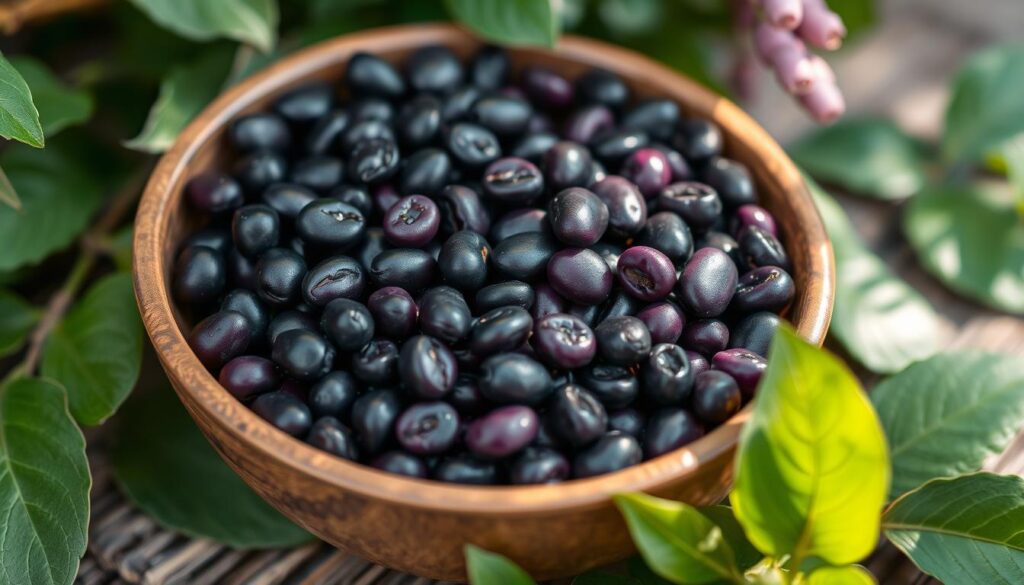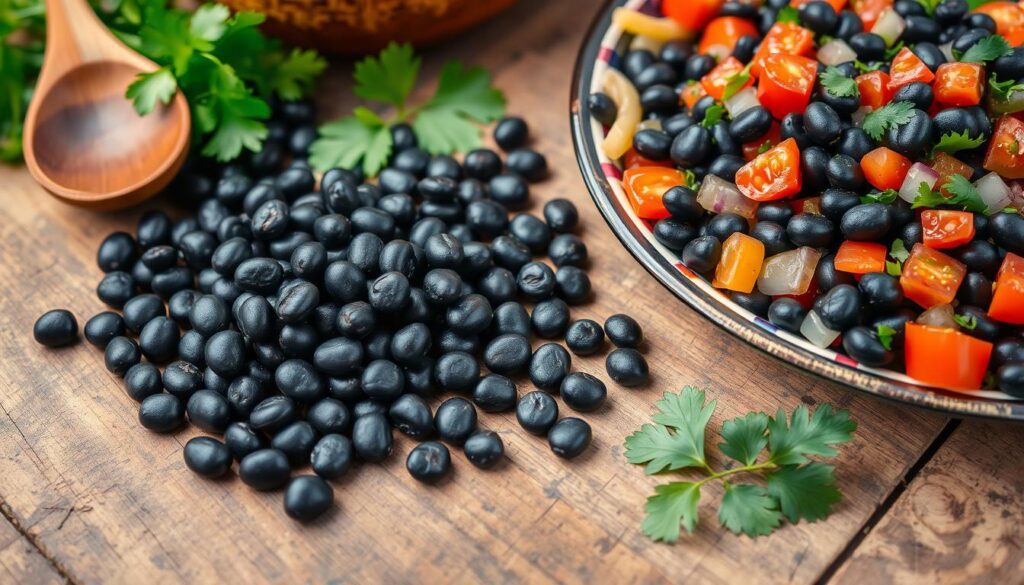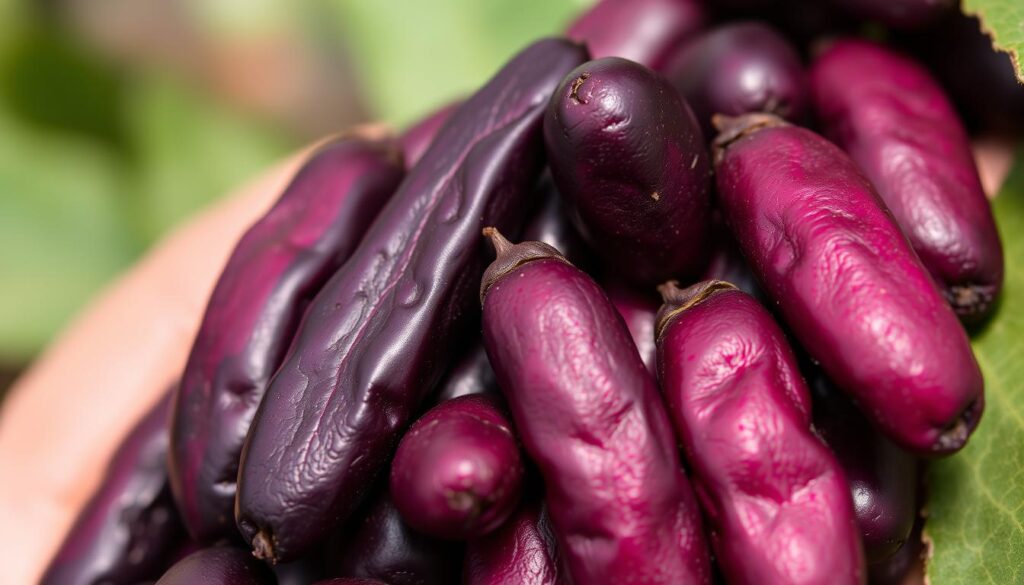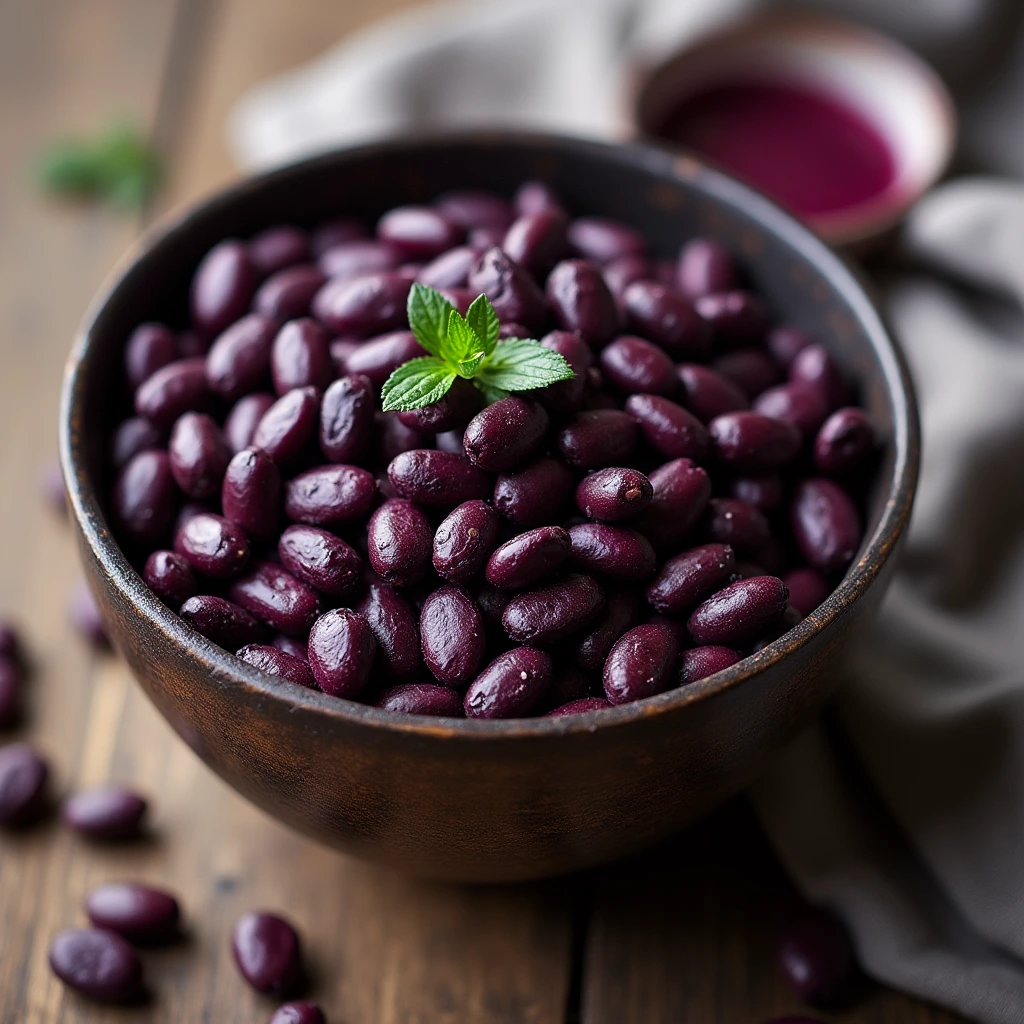Black beans turning purple is a fascinating topic that reveals the complex chemistry of cooking. Understanding anthocyanins, the natural pigments, is key to this color change. These pigments cause black beans to change color, mainly when cooked. The temperature and water quality can greatly influence this change, leading to unexpected colors.
This article explores the science behind this color change. It also talks about the safety of eating purple beans and how to avoid this change. Plus, we’ll share a tasty purple black bean soup recipe. It highlights the beauty and versatility of these beans in cooking.

Key Takeaways
- Black beans can turn purple due to heat disruption of anthocyanins.
- Consistent boiling accentuates the purple color change in beans.
- Alkaline water can alter the color of black beans to blue or greenish.
- Hard water may cause purple or blue hues, while soft water maintains darkness.
- Soaking black beans can lead to pigment leaching affecting color uniformity.
Introduction to Black Beans
Black beans, also known as black turtle beans, are a key ingredient in many cuisines, mainly in Latin America. They are loved for their nutritional value. A cup of cooked black beans has 227 calories, mostly from carbs. This makes them both filling and a great energy source.
Black beans are a nutritional powerhouse. They have about 15 grams of fiber and over 15 grams of protein. They also offer 287% of the Daily Recommended Intake for molybdenum and lots of folate, copper, phosphorus, and iron. You can use them in salads, soups, chili, and burritos, showing their versatility.
Black beans are more than just food. They have antioxidants, antimicrobials, and anti-inflammatories. Eating them can help your heart and control blood sugar. Knowing their nutritional value and cooking uses makes us appreciate them even more.

| Nutrient | Amount per 1 Cup (Cooked) | Percentage of Daily Recommended Intake |
|---|---|---|
| Calories | 227 | – |
| Protein | 15 g | 30% |
| Fiber | 15 g | 60% |
| Molybdenum | – | 287% |
| Folate | – | 64% |
| Copper | – | 40% |
| Iron | – | 20% |
| Magnesium | – | 30% |
Understanding the Color Change
The change in black beans from black to purple is a complex process. It’s all about cooking science. Natural pigments called anthocyanins are key. They make many plant-based foods colorful.
This section explores how these pigments change color when heated. It’s a fascinating transformation.
The Role of Natural Pigments
Natural pigments are essential for the color change in black beans. Anthocyanins, found in fruits and veggies, give black beans their color. When heated, these pigments change, revealing a purple color in the water.
The depth of this color change depends on several factors. The bean variety and freshness are important. Fresher beans have more anthocyanins, making the color change more intense.
What Happens During Cooking?
Cooking black beans changes them in many ways. Heat breaks down the pigments, releasing more anthocyanins. This makes the beans turn a vibrant purple.
The water’s pH level also affects the color. Acidic water makes the beans reddish, while alkaline water turns them bluish or purplish. Heat changes not just the color but also the texture and taste of the beans.
It’s important to cook black beans right. This keeps their color appealing and boosts their nutritional value.

Why Do Black Beans Turn Purple?
Black beans turning purple when cooked is fascinating. The main reasons for color change come from anthocyanins, natural pigments in the beans. These pigments create the stunning colors we see when beans are heated.
When black beans cook, the heat breaks down the anthocyanins into the cooking water. This can lead to a range of colors, from deep purple to blue. The beauty of this change depends on factors like water temperature and pH levels.
The length of cooking time also affects the color change. By controlling these factors, you can get the perfect color and flavor in your dish.
How Do Anthocyanins Cause the Color Change?
Anthocyanins are key in changing the color of black beans. They react to both cooking temperature and time. Knowing how they act during cooking can change how the dish looks.
Impact of Cooking Temperature
Higher cooking temperatures make anthocyanins leach faster. This results in black beans turning a deeper purple. As the temperature goes up, these pigments become less stable. This leads to a more intense color change.
The breakdown of pigments also affects the taste and feel of the dish.
Effect of Cooking Time
Cooking black beans for longer times changes their color more. The longer they cook, the more pigments dissolve. This makes the color change more noticeable.
This change can also impact the beans’ nutritional value. Anthocyanins are antioxidants that help protect against diseases.
Is It Normal for Black Beans to Turn Purple?
It’s normal for black beans to change color when cooked. This change shows the presence of anthocyanins, which are good for you. Many think it’s bad, but it’s actually a sign of the beans’ natural goodness.
Health Benefits of Anthocyanins
Anthocyanins make black beans even healthier. They fight off harmful stress in the body. Eating foods with anthocyanins can help your heart and boost your immune system.
Common Misconceptions About Color Change
Many think black beans turning purple means they’re bad. But it’s just the anthocyanins reacting to heat and pH. Different types of black beans have different amounts of anthocyanins. Knowing this helps us enjoy the beans’ vibrant color and health perks.
Safety of Eating Purple Black Beans
The change in color of purple black beans often worries home cooks. They wonder if the color change means they’re not safe to eat. But, the truth is, the color change is completely safe.
This change happens because of anthocyanins, natural pigments in black beans. These pigments react to pH levels when cooking. So, the beans turn purple.
Despite the color change, purple black beans taste great and are full of nutrients. Some might be surprised by the color change. But, it’s important to know that this change doesn’t harm your health.
Anthocyanins, the pigments, are good for you. They fight inflammation and help prevent chronic diseases. So, the color change is just a sign of their health benefits.
Knowing about food safety with purple black beans can ease your concerns. The color change is just for show. It comes from the beans’ natural makeup, not from any bad reaction. So, you can cook them any way you like without worrying about your health.
How to Prevent Black Beans from Turning Purple
Cooking black beans can sometimes lead to an unexpected color change. Fortunately, several strategies can help prevent the color change and maintain their deep black hue. Incorporating specific cooking practices can work wonders for keeping your beans looking vibrant.
Using Acidic Ingredients
Adding acidic ingredients plays a significant role in stabilizing the color. Ingredients like lemon juice or vinegar, when introduced during cooking, can help maintain the beans’ natural pigmentation. This acidification affects the anthocyanins in the beans, preventing the unwanted purple hue.
Choosing the Right Water
The water quality used in cooking black beans is key. Using softened or filtered water can make a noticeable difference, as hard water may contribute to color change. Alkaline water tends to enhance the purple tint, while using acidic water helps retain the desired color. So, it’s important to consider the water’s pH level during preparation.
Avoiding Overcooking
Careful management of cooking time is vital. Overcooking black beans leads to a breakdown of natural pigments, resulting in an intensified color change. Monitoring the cooking duration to avoid prolonged heat exposure protects the beans from losing their rich black appearance. Quick, attentive cooking ensures the best results.
Why Do Beans Turn Other Colors?
Beans often change color when cooked, thanks to different factors. The pigments in each bean type are key to these changes. Knowing why beans change color helps us learn more about cooking and the different types of beans.
Color Changes in Different Bean Varieties
Each bean type reacts differently to cooking, showing off unique colors. For example, kidney beans might turn reddish, while pinto beans can become brown. This change is mainly due to anthocyanins, which are responsible for red and purple colors in plants.
When cooking black beans, anthocyanins act in a special way. They dissolve in water, changing the bean’s color. Beans can even turn green if boiled for too long. It’s important to cook beans for the right amount of time to keep their bright colors.
To show these changes, here’s a quick guide on how different beans react to cooking:
| Bean Variety | Initial Color | Color After Cooking | Key Pigments |
|---|---|---|---|
| Black Turtle Beans | Dark Purple | Purple | Anthocyanins |
| Kidney Beans | Red | Reddish Brown | Anthocyanins |
| Pinto Beans | Brown | Tan | Anthocyanins |
| Green Beans | Green | Dull Green | Chlorophyll |
This summary shows that color changes in beans make them more appealing. They also show the connection between cooking and the natural chemistry of each bean type. Understanding this can help us cook better and appreciate the variety of beans.
Exploring Black Bean Varieties
Learning about different black bean varieties can make cooking and eating healthier. Each type has its own culinary uses and nutritional differences. Black Turtle Beans, for example, are known for their striking look and health benefits.
Black Turtle Beans are smaller and shinier than regular black beans. They have a dense and meaty texture. They’re great in vegetarian dishes and hold their shape well in soups and stews.
Their flavor is mild with a hint of sweetness, like mushrooms. They’re a favorite in Mexican dishes, like burritos, chili, and enchiladas.
Midnight Black Beans offer a gourmet taste with a dark color. They’re chosen for their unique flavor in fancy recipes. Hybrid black beans also show promise, with traits like disease resistance and high yield.
There’s a push to mix the best traits from traditional and hybrid beans.
To give you a better idea, here’s a table showing some black bean varieties:
| Variety | Size | Texture | Flavor Profile | Culinary Uses |
|---|---|---|---|---|
| Black Turtle Beans | Smaller | Dense and meaty | Mild, slightly sweet | Burritos, chili, soups |
| Midnight Black Beans | Larger | Firm | Rich, intense | Gourmet dishes |
| Traditional Black Beans | Medium | Softer | Bolder, earthy | Salads, sides, tacos |
| Hybrid Varieties | Variable | Varies | Complex | Diverse culinary dishes |
Cooking Tips for Perfect Black Beans
Cooking black beans to perfection is all about the right methods. These methods affect both the texture and flavor. With some helpful tips, you can make your dishes better, whether simple or complex. This section will cover the best cooking methods and flavorful black beans recipes to spark your creativity.
Best Cooking Methods
Choosing the right cooking method is key when cooking black beans. Here are some effective ways:
- Soaking: Soaking black beans overnight can save about 30 minutes of cooking time. Soaked beans cook in 1 to 1.5 hours. Rinsing soaked beans makes them look paler, but un-soaked beans have a richer color and smell.
- Stovetop Cooking: Stovetop methods are best for flavor. Beans without soaking taste better and are easier to digest. Cooking time varies from 1 to 2 hours, depending on the beans’ age.
- Using Filtered Water: Cooking beans in filtered water can make them cook faster. Hard water can slow down the process, so using purified water is better.
Suggestions for Recipes
Adding black beans to your meals can make them healthier and more interesting. Here are some tasty black beans recipes to try:
- Black Bean Salad: Mix cooked black beans with corn, diced tomatoes, avocado, and cilantro. It’s a refreshing dish that goes well with grilled meats.
- Black Bean Soup: A warm soup made with black beans, spices, and veggies. It’s a great comfort food for cold months.
- Black Bean Tacos: Fill tacos with seasoned black beans, lettuce, cheese, and your favorite toppings. It’s a versatile and tasty dish.
| Cooking Method | Advantages | Cooking Time |
|---|---|---|
| Soaking Overnight | Saves time and results in softer beans | 1 to 1.5 hours |
| Stovetop Cooking | Better flavor, easier digestion | 1 to 2 hours |
| Using Filtered Water | Improves cooking time | Varies with water quality |
Popular Black Bean Recipes
Black beans are great for adding flavor and nutrition to many dishes. They make a delicious purple black bean soup and are easy to add to your meals. This helps make your diet healthier.
Purple Black Bean Soup Recipe
This soup is not just tasty but also full of nutrients. It includes:
- 1 cup of dried black beans (soaked overnight for best results or canned for a fast option)
- 1 medium onion, chopped
- 2 cloves of garlic, minced
- 2 cups of vegetable broth
- 1 cup of purple cabbage, shredded
- 1 teaspoon of chipotle powder (optional for spice)
- Salt and pepper to taste
Start by sautéing the onion and garlic until they’re soft. Then, add the soaked black beans, vegetable broth, and purple cabbage. Let it simmer until the beans are tender. For a spicy kick, add chipotle powder. This soup is full of protein, fiber, and antioxidants, which are good for your health.
Ways to Incorporate Black Beans in Your Diet
Black beans are great in many recipes, not just soups. Here are some ideas:
- Mix cooked black beans into salads for added texture and protein.
- Use as a filling for tacos or burritos, complementing ingredients like avocado and salsa.
- Create black bean burgers, combining with breadcrumbs and spices.
- Blend black beans into smoothies for a protein boost.
- Roast black beans with spices for a crunchy snack.
Adding black beans to your meals can make your diet more interesting. It also brings health benefits like better digestion and essential nutrients.
| Dish | Key Ingredients | Health Benefits |
|---|---|---|
| Purple Black Bean Soup | Dried black beans, purple cabbage, onion, garlic | High in protein, antioxidants, and vitamins |
| Black Bean Tacos | Black beans, tortillas, avocado, salsa | Rich in fiber and healthy fats |
| Black Bean Salad | Citrus dressing, corn, black beans, bell peppers | Supports heart health and digestion |
Conclusion
Black beans, known as Phaseolus vulgaris, turn purple when cooked. This shows how complex natural pigments are. It’s not just interesting; it also lets cooks get creative and enjoy the beans’ health benefits.
Learning how to cook black beans well is key. It makes them taste better and keeps their health perks. This is important for anyone who loves to cook.
The change in color comes from many things, like the cooking’s pH level and how the beans are stored. Black beans are great in many dishes, from soups to brownies. They add variety to your meals and bring antioxidants that fight cell damage.
In short, enjoying the colors black beans show is a mix of cooking skill and health awareness. Try new recipes and cooking ways to keep their nutritional value. This way, the purple color of black beans will make your food and health better.
FAQ
Why do black beans turn purple when cooked?
Black beans turn purple because of a natural pigment called anthocyanins. When heated, these pigments change, releasing purple colors into the water.
Are purple black beans safe to eat?
Yes, purple black beans are safe to eat. The color change is just a natural reaction from the anthocyanins. It doesn’t change the taste or texture.
What can I do to prevent my black beans from turning purple?
To keep black beans from turning purple, add lemon juice or vinegar. Use softened or filtered water. Also, cook them carefully to keep their natural color.
Do all beans change color when cooked?
Yes, different beans change color when cooked. Each type reacts differently because of its unique pigments. For example, kidney beans might turn reddish, and pinto beans can go brown.
What are the nutritional benefits of black beans?
Black beans are packed with nutrients. They have lots of protein, fiber, vitamins, and minerals. They’re a key ingredient in many cuisines, like Latin American, because of their health benefits.
How can I incorporate black beans into my meals?
You can add black beans to salads, soups, tacos, and more. They’re versatile and can be used in many recipes, like the purple black bean soup.

